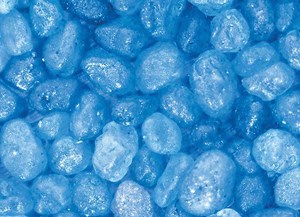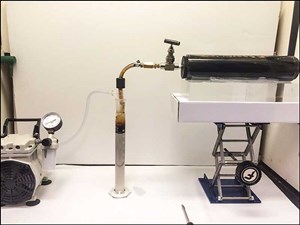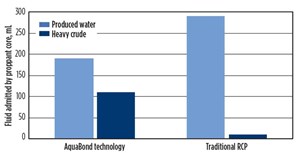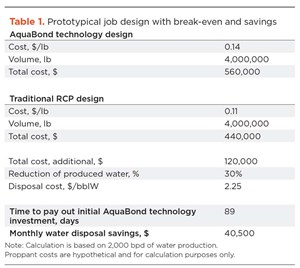Shaletech Report: Proppant coating designed to reduce formation water
Prior to the Covid-19 outbreak, one of the largest headlines within the oil and gas industry was its commitment to sustainability and E&P companies improving their ESG Ratings. This topic has continued to remain top-of-mind for E&P firms and was discussed in a recent SPE Live Interview, where the leader of a supermajor E&P commented, “The water side of the equation is one that is going to continue to get more and more attention. The Permian basin, for example, has very large amounts of water being produced on a daily basis, and the industry has to find a way to manage that.”
SUSTAINABILITY AND ENVIRONMENTAL, SOCIAL AND CORPORATE GOVERNANCE (ESG)
Despite the rapid drop in completion activity, the overall produced water volume across the U.S. is expected to drop only 11%, from 18.1 Bbbl in 2019 to 16.1 Bbbl in 2020. Meanwhile, frac water demand is expected to drop roughly 50%, from 5 Bbbl in 2019 to 2.5 Bbbl in 2020.
In recent years, there has been an increased focus on recycling/reusing produced water for frac activity. While this attention is very promising and much needed, it does not fully address the problem at hand, because the industry will produce roughly 6.5 times as much water than is needed for expected frac activity.
Recycling/reusing produced water for fracturing activity needs to continue to grow in acceptance, but even if we used only produced water for frac activity, there would still be a significant surplus of produced water in the market (IHS Market IQ). The industry needs to look at ways to reduce the production of water at the source, and one of those is keeping that water in the formation.
FORMATION WATER REDUCTION TECHNOLOGY: HOW IT WORKS
Hexion has elected to take on this challenge by developing AquaBond formation water reduction technology, Fig. 1. This proppant coating alters the relative permeability of the proppant pack to preferentially flow hydrocarbons while limiting the admission of water. Proppant coating functional group modification results in a tailored critical surface tension that is hydrophobic, as well as oleophilic. This creates an impelling force that admits oil, while restricting water flow through the proppant pack. Surface energy of the coating is also modified, so hydrocarbons do not cling to the proppant grains and affect permeability.
The coating that is bonded to the proppant possesses this unique water-reducing characteristic. As long as the proppant stays in the formation, the system should remain active for the life of the well. Other commercially available, relative permeability modifiers may wash off and lose efficacy over time.
While reducing the production of formation water is the main feature of this technology, it does have the ability to form grain-to-grain bonds. This gives it the same favorable characteristics of a traditional resin-coated proppant, including proppant flowback control, proppant fines encapsulation, and reduced embedment. While grain-to-grain bonding is not necessary for the technology to achieve water reduction characteristics, this feature does help reduce the risk of the proppant pack degrading over time.
This technology is pumped downhole, just like any other proppant. In fact, the technology has been pumped successfully in slickwater, hybrid, linear and cross-linked fluid systems. While the resin system is very robust, it is recommended that fluid compatibility testing be completed prior to pumping, to ensure that there are no issues on the job site.
To date, AquaBond formation water reduction technology has been pumped successfully in both vertical and horizontal wells across several different basins in the United States (Texas, Louisiana, North Dakota) and Canada (Saskatchewan). The most recent trial was conducted during December 2019 in the U.S. portion of the Bakken shale. For this trial, a major operator and a service provider utilized AquaBond technology on 40/70 mesh fracturing sand as the last 50% of proppant pumped in each stage. This amounted to roughly 4.5 million lb of proppant pumped per well, with the technology used on two out of six wells for this multi-well pad.
Given the current commodity climate, results for this project have not yet been made available, but more information about how the technology has affected long-term well performance is expected later this year. This operator plans to monitor the results for at least 12 months, and if the company sees promising results, it has indicated an appetite to run several more trials across its fields, to further prove out this game-changing technology.
It is important to note that AquaBond technology may not provide an immediate change in water production results, since frac water is returned to surface, as per traditional proppants. Based on experience with a previous, but related differentiated technology, OilPlusTM proppants, significant changes are typically seen around the three-month mark, but positive results can sometimes be realized sooner. OilPlus and AquaBond technologies are used primarily to promote the longevity of the well’s performance. Both technologies are part of the resin system, itself, and are expected to provide these benefits for the life of the well.
CASE STUDIES
Granite Wash. The technology demonstrated its utility in the Granite Wash formation of Wheeler County, Texas. A 23% tail-in of AquaBond on 40/70 substrate was utilized on two horizontal wells. These wells were compared with 11 nearby offset horizontal wells. Three of the adjacent wells used a 23% tail-in of 40/70 traditional resin-coated proppant, and eight wells used 100% raw northern white sand.
All the wells in the study had a true vertical depth (TVD) of about 11,000 ft, with a perforated interval of 4,000 ft, bottomhole static temperature (BHST) of 180°F, and a total proppant usage of approximately 2.3 million lb per well. When comparing the oil and water production for the trial wells, the traditional resin-coated proppant and the uncoated frac sand offsets performed similarly. The data showed a 30% lower water cut and a 43% reduction in the average cumulative water production for the AquaBond technology wells, with no detected impact to total produced fluids.
San Andres formation. In the San Andres formation of Yoakum County, Texas, an operator ran a trial comparing two horizontal wells, utilizing AquaBond technology, to 11 adjacent horizontal wells. The two test wells used a 16.5% tail-in of this technology on 20/40 mesh Northern white sand. The adjacent wells used a 16.5% tail-in of 20/40 traditional resin-coated sand. Each well used a total of 3 million lb of proppant. The TVD was 5,280 ft, with 5,300-ft laterals. All other completion details were similar, and one service company completed all the wells in the study. After four months, the average cumulative water production for the wells incorporating AquaBond technology was 7% lower than the average for the offset wells. The water cut also shifted from 83% to 68%, resulting in higher oil production for the AquaBond technology wells. The average cumulative oil production increased 28%. At $40/bbl of oil, the wells that utilized the AquaBond technology generated $348,000 more in revenue than the offsets, and water disposal was reduced by $75,000 ($1.25/bbl water disposal cost).
HEAVY OIL DATA
AquaBond technology also has been investigated for use in heavy oil production that has high associated water cuts. During lab testing for a supermajor in an onshore field in East Texas, utilization of the formation water reduction technology resulted in major gains in oil cuts vs. traditional resin-coated proppant. The formation produces an average water cut of 98%, with API gravity ranging from 18° to 22°, and average bottomhole temperatures (BHTs) of 120° to 130°F.
The following lab procedure was utilized: First, the produced water (23,000 mg/L TDS) and crude oil (22° API) were heated to the downhole temperature of 127°F, Fig. 2. Next, the fluids were poured into the test cell, which was also heated to BHT. The test cell consists of a consolidated proppant core, which simulates the proppant pack, and provides the only conduit for fluids to leave the cell. The fluids placed into the cell consisted of 400 ml of produced water and 200 ml of crude oil. Using a vacuum pump, 300 ml of the fluids were pulled through the proppant core, out into a graduated cylinder to measure the oil-to-water ratios. These tests utilized 20/40 frac sand coated with AquaBond technology and a 20/40 traditional resin-coated proppant as the control. The results are shown in Fig. 3. The AquaBond technology core had an oil cut of 37%, while the traditional resin-coated proppant control had an oil cut of only 3%.
PROPOSED JOB DESIGN AND BREAK-EVEN
Consider a well producing 2,000 bbl of water per day, with disposal costs of $2.25/bbl of water, Table 1. Even if AquaBond technology is more expensive than a traditional resin-coated proppant, savings from reducing the water production would offset the original investment in less than 90 days. This assumes that the technology could reduce water production by 30%. Additional savings would also come from avoiding downtime, due to proppant flowback and lower costs to treat produced water. Additional revenue is not considered in this calculation, although previous trials have resulted in increased production compared to offsets.
CONCLUSION
Formation water production continues to be an issue in the oil field, even with recent reduction in activity. Treating, trucking, and disposing of formation water has a major impact on well economics, especially in the current low oil-price environment. Hexion has developed a solution to keep formation water in the ground while still being able to produce hydrocarbons. AquaBond formation water reduction technology is a proppant coating that preferentially flows hydrocarbons over water through the proppant pack. This technology has been used successfully in various shale plays across North America.
- Shale technology: Bayesian variable pressure decline-curve analysis for shale gas wells (March 2024)
- Water management (February 2024)
- When electric meets intelligence: Powering a new era in hydraulic fracturing (January 2024)
- Next-generation electric fracturing system improves efficiency, ESG performance (January 2024)
- Offshore potable water production from subsea karstic aquifers (November 2023)
- Singlet oxygen-generating treatment technology achieves sustainable operations, helps operators meet production goals (November 2023)






